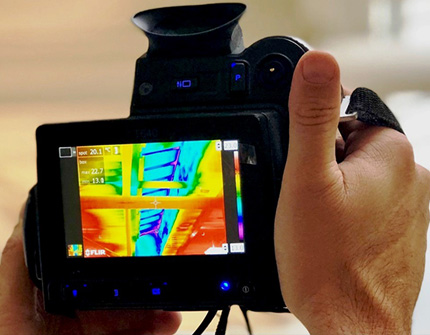Thermographic Building Surveys to Identify Building Faults
In our experience Building Thermographic Inspections is one of the quickest and most accurate means to identify faults within a building envelope or mechanical and electrical installations. Thermal cameras can be used to scan large areas quickly – such as large warehouses, or residential blocks to identify anomalies such as defective insulation or areas of dampness and trace and record paths in a way that other methods cannot. Thermography is also a non-invasive, non-contact and hence non-destructive means of surveying the building envelope.

Energy losses through the building fabric might be the result of poor design, low-quality materials, poor workmanship, poor maintenance, or changes that have been made since completion. According to the Technology Strategy Board, in the UK, the built environment accounts for 50% of total carbon emissions (25% from domestic buildings and 18% from commercial buildings ). Much of this is wasted, through: inefficient operation; inefficient equipment, appliances, machinery and plant; and losses through the building fabric. These losses can go unnoticed as the problem may be hidden within the building fabric.
Thermographic Building surveys can help identify problems, using infrared cameras to reveal differences in surface temperatures. They locate areas of the building fabric that may be hotter or colder than surrounding areas, suggesting that there are specific losses in that area. The easy to identify and immediate visual nature of the thermal imaging survey results, can offer a relatively inexpensive and non-invasive way of helping customers to understand the significance of problems that might otherwise be difficult to conceptualise.
Thermographic building surveys can be both quantitative and qualitative and they can be used both internally and externally on all types of buildings to check if:
-
-
-
-
- The quality of materials and workmanship is consistent.
- To check if the building design and specification has been complied with.
- Whether there is continuity of insulation within the building envelope.
- Wet insulation within the building envelope.
- Problems with cladding.
- Structural defects.
- Air leakage and air infiltration through the building envelope.
- Problems with all types of M&E systems including heating, cooling and ventilation systems.
- Problems with curtain walling glazing, doors and seals.
- Cold bridging within building junctions
-
-
-
Thermal imaging surveys can also be used to:
-
-
-
-
- Identify problems related to moisture penetration through the building envelope..
- Locate damaged under-flooror underground pipes.
- Identify problems related to moisture ingress
- Locate blockages in flues.
- Locate problems in electrical installations
- locate problems in mechanical installations
- Illustrate improvements made after a retrofit programme.
-
-
-
Whilst thermographic surveys may be relatively inexpensive to undertake , the problems identified can be very costly to rectify as they may involve deconstructing elements of a building, or may be issues that repeat throughout the building poorly installed cladding insulation.
Thermal imaging surveys might be undertaken for a single building, several buildings, a site or an organisation, and might be carried out for commercial or domestic clients. It might be undertaken as an isolated study, or as part of a wider energy audit undertaken to assess total energy use and propose measures to reduce consumption and costs. See Energy audit for more information.
Thermal Imaging surveys also require certain environmental conditions, for example an external survey should be carried out when there is no direct solar radiation. In addition, energy assessment methods such as BREEAM may require that at a thermographic survey is undertaken. The UK Thermography Association (UKTA) is an association created to accredit, support and unite those involved in infrared thermal imaging.
We use the latest high resolution thermal imaging cameras to undertake our Thermographic Surveys throughout London and the Southeast. Thermal imaging is one the quickest and easiest ways to undertake fault diagnosis on your buildings, as thermography can quickly and accurately identify building faults and a easy to follow report, so the defects can be quickly indented and rectified by the contractors.
All our engineers are Level 3 trained thermographers, be understated as they are trained to be write predictive maintenance and inspection practices and to develop test procedures and ascertain severity criteria. To try and help clients prepare for the thermal imaging survey to their building, we have written the following article: How we carry our thermal Surveys on commercial buildings.
To try and help facility managers with their electrical and mechanical surveys, we have also written the following article: thermal imaging inspections for facilities management. Also, throughout the UK BREEAM projects are becoming more common place. BREEAM provides extra points to projects that have a BREEAM Thermal survey undertaken. As not many clients are aware of BREEAM thermal surveys, so we have included more information in our ‘What is a BREEAM thermal Imaging Survey’ article. Also to try and help clients prepare for their survey please download our Thermal Imaging Checklist.
The benefits of thermographic inspections are well documented and when it’s used in conjunction with air tightness testing it can be a very power combination – especially when its undertaken on commercial buildings.
If you would like more information on our London thermal surveys packages, please contact us at info@aptsoundtesting.co.uk or call us on 01525 303905. Alternatively for more information on thermal surveys please visit our website at www.aptsountesting.co.uk or download our thermal survey checklist.
